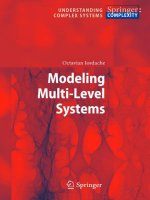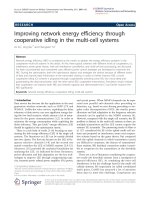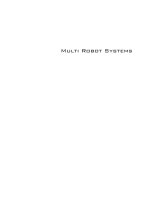- Trang chủ >>
- Mẫu Slide >>
- Văn Bản - Text
MULTI AGENT SYSTEMS
Bạn đang xem bản rút gọn của tài liệu. Xem và tải ngay bản đầy đủ của tài liệu tại đây (235.55 KB, 32 trang )
MULTI-AGENT SYSTEMS
Reference
[1] Michael Wooldridge, “An Introduction to MultiAgent Systems”,
Second Edition, 2009
[2] R.H. Bordini, J.F.Hubner, M. Wooldridge, “Programming multi-
agent systems in AgentSpeak using Jason”, 2007.
2
Outline
Background
Agent
Environment
Architecture for Agents
Reading: Chapter 1&2, [1]
3
Background
Distributed Artificial Intelligence (DAI)
Subfield of AI
Development of distributed solutions for complex problems
problem that is beyond the capability of an individual problem
solver
Two mainstreams
Distributed prolem solving (DPS)
MultiAgent systems (MAS)
4
Background
Distributed Artificial Intelligence (DAI)
Two mainstreams
Distributed prolem solving (DPS)
Centralized Control, Distributed Data
MultiAgent systems (MAS)
Distributed Control, Distributed Data
a system comprising several agents that “live” and interact in the same
environment.
5
Outline
Background
Agent
Environment
Architecture for Agents
6
Example
Cleaning robot
Gold miners
7
What is an Agent?
There is no universally accepted definition of the term “Agent”
There is a general consensus that autonomy is central to the
notion of agency.
Difficulty is that various attributes associated with agency are
of diffening importance for different domains.
8
What is an Agent?
Autonomy:
capable of acting independently,
exhibiting control over their internal state
Thus: an agent is a computer system capable of autonomous action
in some environment in order to meet its design objectives
9
SYSTEM
ENVIRONMENT
input
output
What is an Agent?
An agent in its environment
10
Environment
?
Sensors
Feedback
Actions
What is an Agent?
In most domain of reasonable complexity, an agent will not have
complete control over its environment.
It will have at best partial control, in that it can influence it.
11
What is an Agent?
Trivial (non-interesting) agents:
Thermostat
Have a sensor for detecting room temperature
Two signals: too low, and OK
Available actions: heating on , and heating off
Rules:
Too cold heating on
Temperature Ok heating off
When the door of the room is close? guaranteed effects
When the door of the room is open?
12
What is an Agent?
An intelligent agent is a computer system capable of flexible
autonomous action in some environment
By flexible, we mean:
reactive
pro-active
social
13
Reactivity
If a program’s environment is guaranteed to be fixed, the program
need never worry about its own success or failure – program just
executes blindly
Example of fixed environment: compiler
The real world is not like that: things change, information is
incomplete. Many (most?) interesting environments are dynamic
14
Reactivity
A reactive system is one that maintains an ongoing interaction
with its environment, and responds to changes that occur in it
(in time for the response to be useful)
15
Proactiveness
we generally want agents to do things for us
goal directed behavior
Pro-activeness = generating and attempting to achieve goals;
not driven solely by events; taking the initiative
Recognizing opportunities
16
Social Ability
The real world is a multi-agent environment: we cannot go around attempting
to achieve goals without taking others into account
Some goals can only be achieved with the cooperation of others
Social ability in agents is the ability to interact with other agents (and possibly
humans) via some kind of agent-communication language, and perhaps
cooperate with others
17
Outline
Background
Agent
Environment
Abstract Architecture for Agents
23
Environments
Accessible vs. inaccessible
An accessible environment is one in which the agent can obtain complete,
accurate, up-to-date information about the environment’s state
Most moderately complex environments (including, for example, the
everyday physical world and the Internet) are inaccessible
24
Environments
Accessible vs. inaccessible
The more accessible an environment is, the simpler it is to build
agents to operate in it
Example:
a vacuum agent with only a local dirt sensor cannot tell whether there is
dirt in other squares,
an automated taxi cannot see what other drivers are thinking
25
Environments
Deterministic vs. non-deterministic
A deterministic environment is one in which any action has a single
guaranteed effect — there is no uncertainty about the state that will
result from performing an action
26
Environments
Deterministic vs. non-deterministic
Example:
The vacuum world as we described it is deterministic, but variations
can include stochastic elements such as randomly appearing dirt
and an unreliable suction mechanism
Taxi driving is clearly non-deterministic in this sense, because one
can never predict the behavior of traffic exactly; moreover, one's
tires blow out and one's engine seizes up without warning
27
Environments
Static vs. dynamic
A static environment is one that can be assumed to remain
unchanged except by the performance of actions by the agent
A dynamic environment is one that has other processes
operating on it, and which hence changes in ways beyond the
agent’s control
28
Environments
Static vs. dynamic
Other processes can interfere with the agent’s actions (as in
concurrent systems theory)
The physical world is a highly dynamic environment
Example:
Taxi driving is clearly dynamic
Crossword puzzles are static
29
Environments
Discrete vs. continuous
An environment is discrete if there are a fixed, finite number
of actions and percepts in it
Russell and Norvig give a chess game as an example of a
discrete environment, and taxi driving as an example of a
continuous one
30









